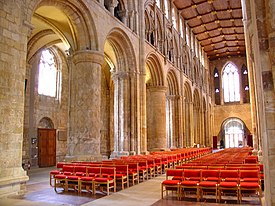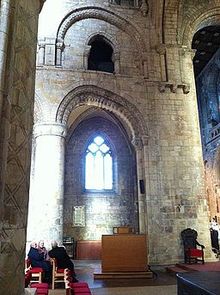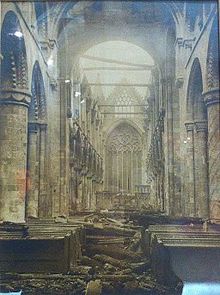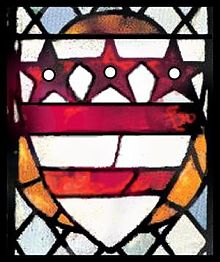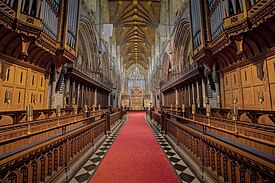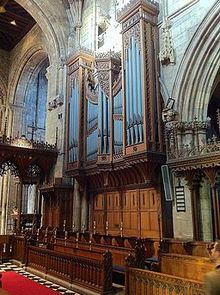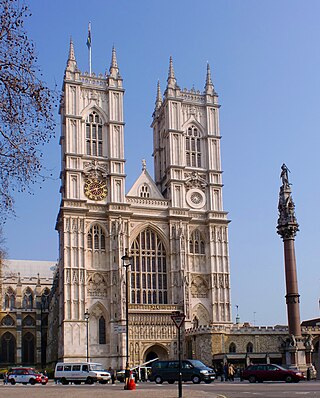
Westminster Abbey, formally titled the Collegiate Church of Saint Peter at Westminster, is an Anglican church in the City of Westminster, London, England. Since 1066, it has been the location of the coronations of 40 English and British monarchs and a burial site for 18 English, Scottish, and British monarchs. At least 16 royal weddings have taken place at the abbey since 1100.

Canterbury Cathedral is the cathedral of the archbishop of Canterbury, the leader of the Church of England and symbolic leader of the worldwide Anglican Communion. Located in Canterbury, Kent, it is one of the oldest Christian structures in England and forms part of a World Heritage Site. Its formal title is the Cathedral and Metropolitical Church of Christ, Canterbury.
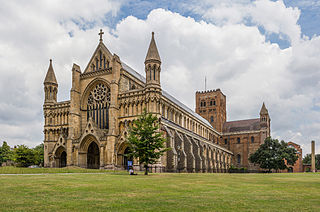
St Albans Cathedral, officially the Cathedral and Abbey Church of St Alban but often referred to locally as "the Abbey", is a Church of England cathedral in St Albans, England.

Sherborne Abbey, otherwise the Abbey Church of St. Mary the Virgin, is a Church of England church in Sherborne in the English county of Dorset. It has been a Saxon cathedral (705–1075), a Benedictine abbey church (998–1539), and since 1539, a parish church.
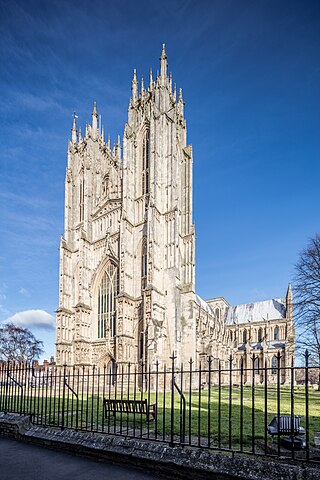
Beverley Minster, otherwise known as the Parish Church of Saint John and Saint Martin, in Beverley, East Riding of Yorkshire, is a parish church in the Church of England. It is one of the largest parish churches in the UK, larger than one-third of all English cathedrals and regarded as a Gothic masterpiece by many.

Hexham Abbey is a Grade I listed church dedicated to St Andrew, in the town of Hexham, Northumberland, in the North East of England. Originally built in AD 674, the Abbey was built up during the 12th century into its current form, with additions around the turn of the 20th century. Since the Dissolution of the Monasteries in 1537, the Abbey has been the parish church of Hexham. In 2014 the Abbey regained ownership of its former monastic buildings, which had been used as Hexham magistrates' court, and subsequently developed them into a permanent exhibition and visitor centre, telling the story of the Abbey's history.
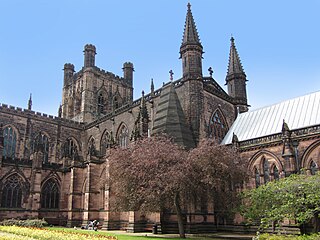
Chester Cathedral is a Church of England cathedral and the mother church of the Diocese of Chester. It is located in the city of Chester, Cheshire, England. The cathedral, formerly the abbey church of a Benedictine monastery dedicated to Saint Werburgh, is dedicated to Christ and the Blessed Virgin Mary. Since 1541, it has been the seat of the Bishop of Chester.

Carlisle Cathedral is a Grade I listed Anglican cathedral in the city of Carlisle, Cumbria, England. It was founded as an Augustinian priory and became a cathedral in 1133. It is also the seat of the Bishop of Carlisle.

Priory Church of St Mary, Bridlington, grid reference TA177680, commonly known as Bridlington Priory Church is a parish church in Bridlington, East Riding of Yorkshire, England, in the Diocese of York. It is on the site of an Augustinian priory founded in 1113 which was dissolved during the Dissolution of the Monasteries. In 1951 it was designated a Grade I Listed Building.

Saint-Étienne-du-Mont is a church in Paris, France, on the Montagne Sainte-Geneviève in the 5th arrondissement, near the Panthéon. It contains the shrine of St. Geneviève, the patron saint of Paris. The church also contains the tombs of Blaise Pascal and Jean Racine. Jean-Paul Marat is buried in the church's cemetery.

The Church of Saint-Germain-des-Prés is a Roman Catholic parish church located in the Saint-Germain-des-Prés quarter of Paris. It was originally the church of a Benedictine abbey founded in 558 by Childebert I, the son of Clovis, King of the Franks. It was destroyed by the Vikings, rebuilt, and renamed in the 8th century for Saint Germain, an early Bishop of the city. it was rebuilt with elements in the new Gothic style in the eleventh century, and was given the first flying buttresses in Paris in the 12th century. It is considered the oldest existing church in Paris.

The Collegiate Church of St Mary is a Church of England parish church in Warwick, Warwickshire, England. It is in the centre of the town just east of the market place. It is grade I listed, and a member of the Major Churches Network.

St Martin in the Bull Ring is a Church of England parish church in the city of Birmingham, West Midlands, England. It is the original parish church of Birmingham and stands between the Bull Ring Shopping Centre and the markets.

The Church of Saint-Germain l'Auxerrois is a medieval Roman Catholic church in the 1st arrondissement of Paris, directly across from the Louvre Palace. It was named for Saint Germanus of Auxerre, a medieval bishop of Auxerre, who became a papal envoy and met Saint Genevieve, the patron saint of Paris, on his journeys. Genevieve is reputed to have converted queen Clotilde and her husband, French king Clovis I to Christianity at the tomb of Saint Germain in Auxerre.

Howden Minster is a large Grade I listed Church of England church in the Diocese of York. It is located in Howden, East Riding of Yorkshire, England and is one of the largest churches in the East Riding. It is dedicated to St Peter and St Paul and it is therefore properly known as 'the Minster Church of St Peter and St Paul'. Its Grade I listed status also includes the Chapter House.

St Peter's Church is a Church of England parish church located in the centre of Bournemouth, Dorset, England. It is a Grade I listed building classed as a 'major parish church', and was completed in 1879 to a design by George Edmund Street as the founding mother church of Bournemouth.

Leeds Minster, or the Minster and Parish Church of Saint Peter-at-Leeds is the minster church of Leeds, West Yorkshire, England. It stands on the site of the oldest church in the city and is of architectural and liturgical significance. A church is recorded on the site as early as the 7th century, although the present structure is a Gothic Revival one, designed by Robert Dennis Chantrell and completed in 1841. It is dedicated to Saint Peter and was the Parish Church of Leeds before receiving the honorific title of "Minster" in 2012. It has been designated a Grade I listed building by Historic England.

The Minster Church of St Nicholas is the minster and parish church of the town of Great Yarmouth, in Norfolk, England. It was built during the Norman era and is England's third largest parish church, behind Beverley Minster in East Yorkshire and Christchurch Priory in Dorset. It was founded in 1101 by Herbert de Losinga, the first Bishop of Norwich, and consecrated in 1119. It is cruciform, with a central tower, which may preserve a part of the original structure. Gradual alterations effectively changed the form of the building. Its nave is 26 feet (7.9 m) wide, and the church's total length is 236 feet (72 m).
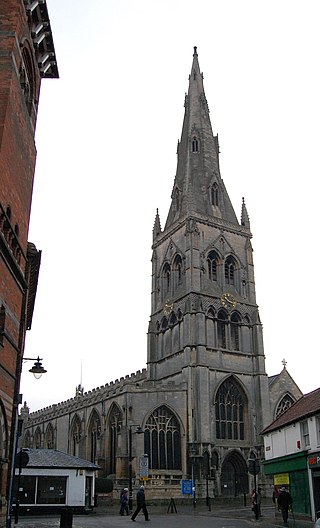
St Mary Magdalene Church, Newark-on-Trent is the parish church of Newark-on-Trent in Nottinghamshire, England. It is dedicated to Mary Magdalene and is the tallest structure in the town.

Wakefield Cathedral, or the Cathedral Church of All Saints in Wakefield, West Yorkshire, England, is a co-equal Anglican cathedral with Bradford and Ripon Cathedrals, in the Diocese of Leeds and a seat of the Bishop of Leeds. Originally the parish church, it has Anglo Saxon origins and, after enlargement and rebuilding, has the tallest spire in Yorkshire. Its 247-foot (75 m) spire is the tallest structure in the City of Wakefield. The cathedral was designated a Grade I listed building on 14 July 1953.


